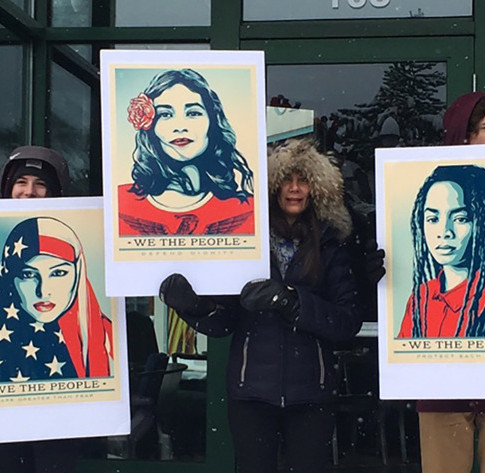Editorial: Behind the signs of the Women’s March
- The Review
- Jan 24, 2018
- 3 min read
On Saturday, the second Women’s March was held in Washington D.C. and several other major U.S. cities. Held on the anniversary of Trump’s swearing into office, the goal of the Women’s March is to “harness the political power of diverse women and their communities to create transformative social change,” according to their website.
Attendees brandished signs with a colorful array of captions, many of which have gone viral on the Internet. One woman merged pop culture with politics and wrote “eat a tide pod, patriarchy!” on her sign, while others bore more conventional terms, such as “girl power” or “the future is female.” Many of the signs addressed Trump and his presidency, such as “Trump, repeta a los migrantes” and “watch out, Trump: my generation votes next.”
The photos of the 200,000 individuals marching in D.C. for a united cause are powerful. People of all demographics wore the signature pink knitted hats, wore signs with inspirational sayings, and chanted cries for empowerment and equality for all. In this vibrant mosaic of a nationwide protest, it can be easy to focus too much on the event itself and lose sight of why these women are protesting. Of course, the clever sayings and now-iconic beanies make a statement, but the cause behind the pictures cannot be forgotten,otherwise the purpose of the protesters is lost.
Included in the Women’s March mission statement is that they are dedicated to “dismantling systems of oppression” and “building inclusive structures.” They claim that Women’s Rights are Human Rights, and vice versa. No person is to be left out, and they specifically point out that all women are included within this new structure. Within the word “women,” Women’s March brings “Black women, Native women, poor women, immigrant women, disabled women, Muslim women, lesbian queer and trans women” together, and sends a reminder that other issues, such as racism, must be included in the fight against sexism.
The #MeToo campaign and “Time’s Up” movement that emerged out of 2017’s immense amount sexual allegations against powerful men became the catalyst for a new revision in the Women’s March protest. It has become even clearer what actions are reprehensible and should never be tolerated and that support groups are there to protect and comfort those abused and fight the people and system that makes those abuses possible. But the Women’s March is not just about making positive change for women, but positive change for all.
Women’s March lists “Unity Principles” for their movement on their website, which include “ending violence,” “workers’ rights” and “immigrant rights” – all key issues in politics during the past few months. The protesters’ stances on these issues are clear and vary in controversy, but each platform is rooted in inclusion and freedom for all. While immigration laws are being argued, Women’s March calls us to “believe in immigrant and refugee rights regardless of status or country of origin.” As new incidents of sexual assault are brought to our attention each day, Women’s March holds everyone to the standard that “women deserve to live full and healthy lives, free of all forms of violence against our bodies.”

The Women’s March is a concrete display of the magnitude of the importance of the fight for a pro-woman society as women from all walks of life came together for a common cause. Women celebrities in literature and film have been using their platforms as a way to promote feminism as well, such as the revival of “The Handmaid’s Tale” by Margaret Atwood, the publication of “The Power” by Naomi Alderman, and movies such as “Wonder Woman” and “Hidden Figures.” These pro-woman medias are small steps toward a feminist norm, a norm that should make the surprising headline – “The three top-grossing films of 2017 had female leads for the first time in nearly sixty years” – obsolete.
Behind the poster-boards and pink, the individuals who marched on Saturday lived and breathed these principles and the many others that the symbolic event represented. It’s not enough for us to just watch and listen to the activist’s call for change. It’s time to react.
The only way protests like this one are effective is if they promote action and conversation. Use these protests as an opportunity to talk with people and find out what their opinions are. Even if they disagree with you, find out why. Dialogue is what makes understanding possible. It is the effort from individuals who strive to understand that creates change. Individuals make a difference. One person can break an individual; one person can heal them.
Photos: NBC News










Comments